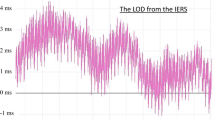Abstract
IT is the purpose of this communication to suggest that the centimetre and millimetre scale roughness of the lunar surface has been produced by the impact of small meteorites rather than by internal volcanic effects. The high degree of roughness of these dimensions was first indicated as a result of infra-red measurements1 and has been confirmed by radar measurements2, by measurements at millimetre wavelengths3 and more recently by the Russian and American soft-landing photographs.
Similar content being viewed by others
References
Gear, A. E., and Bastin, J. A., Nature, 196, 1305 (1962).
Pettingill, G. H., Proc. Roy. Soc. Lunar Meeting (1965) (in the press).
Bastin, J. A., Clegg, P. E., Gear, A. E., Jones, G. O., and Platt, C. M., Nature, 203, 960 (1964).
Fielder, G., Proc. Roy. Soc. Lunar Meeting (1965) (in the press).
McCracken, C. W., and Dubin, M., The Lunar Surface Layer, edit. by Salisbury, J. W., and Glaser, P. E., 179 (Academic Press, 1964).
Weil, N. A., Lunar and Planetary Surface Conditions (Academic Press, 1965).
Baldwin, R. B., The Measure of the Moon (Univ. of Chicago Press, 1963).
Author information
Authors and Affiliations
Rights and permissions
About this article
Cite this article
BASTIN, J. Small Scale Lunar Roughness. Nature 212, 171–173 (1966). https://doi.org/10.1038/212171a0
Issue Date:
DOI: https://doi.org/10.1038/212171a0
- Springer Nature Limited
This article is cited by
-
Recent observations of the Moon by spacecraft
Space Science Reviews (1969)





